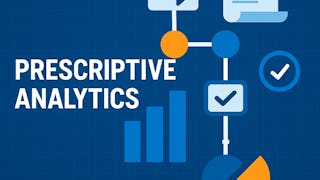Learn to transform data into actionable strategies in Prescriptive Analytics for Digital Transformation. Use Python to build and solve optimization models, tackle complex decisions, and leverage prescriptive tools to drive efficient, data-driven innovations with Dartmouth Thayer School of Engineering faculty Vikrant Vaze and Reed Harder.


您将获得的技能
- Operations Research
- Decision Making
- Business Mathematics
- Analytics
- Feature Engineering
- Python Programming
- Mathematical Software
- Strategic Decision-Making
- Operational Analysis
- Process Analysis
- Data-Driven Decision-Making
- Digital Transformation
- Business Analytics
- Cloud Computing
- Process Optimization
- Predictive Analytics
- Complex Problem Solving
- Logistics
- Data Science
要了解的详细信息

添加到您的领英档案
11 项作业
了解顶级公司的员工如何掌握热门技能

积累特定领域的专业知识
- 向行业专家学习新概念
- 获得对主题或工具的基础理解
- 通过实践项目培养工作相关技能
- 获得可共享的职业证书

该课程共有6个模块
涵盖的内容
2个视频10篇阅读材料1个作业3个非评分实验室
Optimization is a valuable prescriptive analytics tool for any organization looking to undertake digital transformation, as it maximizes the power of data and computer programming languages which are increasingly available to even small business owners. The ability to predict outcomes, such as unit costs, market shares, prices, and capacities, and to then take the best course of action that maximizes returns and minimizes cost and risk, is the force behind many of the world’s most successful companies. The key to long-term success, though, is the ability to continually integrate the insights of both predictive and prescriptive analytics.
涵盖的内容
3个视频6篇阅读材料2个作业3个非评分实验室
In this unit, you will explore how linear optimization models serve as a powerful tool for decision-making within the framework of digital transformation. By leveraging analytics and digital technologies, linear optimization enables managers to make strategic decisions efficiently. You will deepen your understanding of when and how non-linear models can be transformed into linear ones. Specifically, you’ll learn to identify scenarios where linearization techniques work effectively, including the use of absolute values and piecewise linear functions. Through real-world examples, such as inventory management and advertising optimization, you’ll gain practical insights into translating complex decision-making problems into linear formulations. This unit will also introduce the geometric representation of linear optimization problems, helping you develop intuition about their solution methods. You will learn about active and inactive constraints at optimality and perform sensitivity analysis, empowering you to assess how changes in resources or constraints impact optimal solutions. Finally, you will see how digital tools and cloud-based platforms, such as Pyomo, make implementing linear optimization models both scalable and accessible in modern business environments.
涵盖的内容
3个视频5篇阅读材料2个作业4个非评分实验室
In this unit, we build upon the foundational principles of linear optimization and explore how introducing integer variables into optimization models allows for greater flexibility in solving complex, real-world decision-making problems. While integer variables can increase computational complexity, they unlock the ability to model many important constraints and relationships that are integral to effective business strategies. Through practical examples, such as warehouse location optimization and infrastructure project selection, you will learn how to formulate and solve mixed-integer linear optimization problems. These examples will demonstrate how integer variables enable precise modeling of discrete decisions, such as whether to open a warehouse, invest in a project, or allocate resources to specific activities. You will also explore advanced techniques, such as combining constraints to enforce logical rules and leveraging logic tables to verify model formulations. By the end of this unit, you will understand how to apply mixed-integer linear optimization to enhance managerial decision-making within the context of digital transformation.
涵盖的内容
2个视频5篇阅读材料2个作业3个非评分实验室
This unit delves into advanced optimization techniques using Python, focusing on how digital transformation can leverage prescriptive analytics tools to solve complex decision-making problems. Building on your knowledge of linear and integer optimization, you will explore the branch-and-bound method for solving binary integer optimization problems. This technique is crucial for addressing real-world scenarios where decisions are discrete, such as investment portfolios, resource allocation, or facility planning. Through the example of portfolio optimization, you will learn to formulate and solve binary integer optimization models using Python, understand the concept of linear relaxation and its role in generating bounds for optimal solutions, and apply the branch-and-bound method to systematically explore and prune solution spaces, ensuring efficient and effective problem-solving. This unit bridges theoretical optimization techniques with practical implementation, empowering you to use Python to make data-driven, optimized decisions for digital transformation initiatives.
涵盖的内容
2个视频4篇阅读材料2个作业3个非评分实验室
The final unit of this course is a practicum that serves as a mini-capstone project, allowing you to consolidate your learning and demonstrate mastery of the tools and techniques introduced throughout the course. This project is your opportunity to apply prescriptive analytics, cloud-based tools, and data science methodologies to a practical business problem, providing actionable insights that align with digital transformation initiatives. You will synthesize your project into a short written report. This report should detail how you developed your mathematical model(s) and how you ran the code in Python. What challenges did you encounter? What adjustments were needed to successfully run the code? What insights did you glean from the data analyses? How might you formulate recommendations for action to key stakeholders in a way that would be understandable and persuasive? The ability to answer these and other similarly applicable questions will prepare you for data science roles that help businesses harness the power of analytics.
涵盖的内容
3篇阅读材料2个作业1个非评分实验室
获得职业证书
将此证书添加到您的 LinkedIn 个人资料、简历或履历中。在社交媒体和绩效考核中分享。
从 Machine Learning 浏览更多内容
 状态:预览
状态:预览O.P. Jindal Global University
 状态:免费试用
状态:免费试用University of Minnesota
 状态:免费试用
状态:免费试用Dartmouth College
 状态:免费试用
状态:免费试用University of Minnesota
人们为什么选择 Coursera 来帮助自己实现职业发展




常见问题
To access the course materials, assignments and to earn a Certificate, you will need to purchase the Certificate experience when you enroll in a course. You can try a Free Trial instead, or apply for Financial Aid. The course may offer 'Full Course, No Certificate' instead. This option lets you see all course materials, submit required assessments, and get a final grade. This also means that you will not be able to purchase a Certificate experience.
When you enroll in the course, you get access to all of the courses in the Specialization, and you earn a certificate when you complete the work. Your electronic Certificate will be added to your Accomplishments page - from there, you can print your Certificate or add it to your LinkedIn profile.
Yes. In select learning programs, you can apply for financial aid or a scholarship if you can’t afford the enrollment fee. If fin aid or scholarship is available for your learning program selection, you’ll find a link to apply on the description page.
更多问题
提供助学金,





